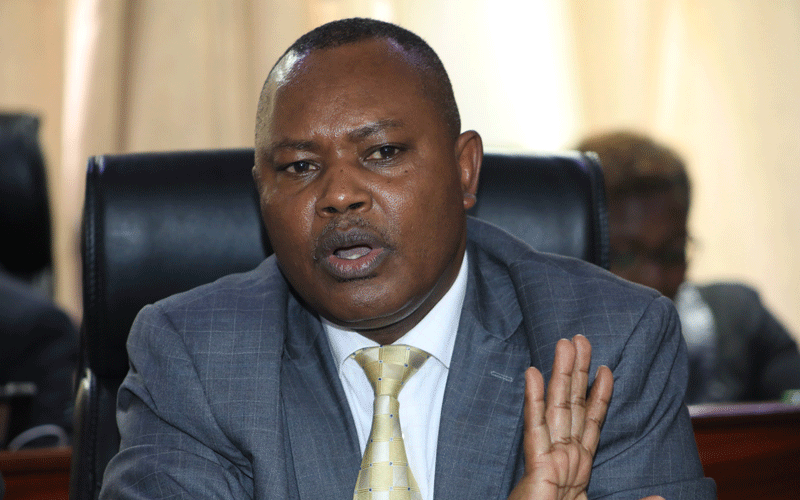How crime busting has gone hi-tech with new forensic lab

The fight against crime will now go hi-tech following the completion of the police forensic laboratory.
Already, Director of Criminal Investigations (DCI) George Kinoti says a team of detectives, assembled over the last two months, has been analysing reside samples collected from the scenes of serious crimes such as murders, attempted murders, hijackings, house robberies and possession of illegal firearms in the new laboratory.
And it is instant. Using forensic laboratory, a ballistic analysis has linked the firearm that was robbed from an officer based at the police headquarters early 2018 to more than 20 violent robberies especially in Kisumu county.
Between March 24 and November 28, 2019 when the main suspect was arrested, the gang had committed more than 100 robberies.
In 15 of the cases analysed, they shot and injured two people, stole over Sh3 million and fired several rounds of ammunition.
A total of 29 spent cartridges and one live round of ammunition were found at the scenes and which were collected for analysis.
Spent cartridges
In one of the robberies committed by the gang at Dago PAG Church on July 1, 2019 where they robbed Sh2.03 million belonging to the Inua Jamii programme, six spent cartridges were found.
“When a gun is fired, traces of gunpowder are often left at the crime scene, or on the clothes of victims or suspects.
These tiny traces often hold crucial keys to solving the crime, especially when paired with evidence from other forensic services such as ballistics analysis,” says Kinoti.
He adds: “Evidence cannot be looked at in isolation, so everything must be looked at holistically, working with other departments, in order to piece together the puzzle.”
An analysis at the recently acquired state-of-the-art equipment at the DCI headquarters enabled detectives to link cases that were otherwise not known to be related, and identified new leads and suspects.
A ballistic expert who spoke to People Daily said firearms leave unique microscopic markings on the surface of bullets and cartridge cases. “Ballistic experts then compare these markings to crime scenes and recovered firearms,” he said. 
After the firearm is recovered, detectives then analyse and compare to confirm whether the firearm was used in the commission of an alleged offence.
The DCI boss said following a thorough ballistic analysis that culminated in the arrest of the main suspect, they managed to bust the crime.
On November 28, detectives acting on a tip-off raided the house of notorious suspect identified as Fredrick Odhiambo Nundu alias ‘Gilbert Wafula Makhoka’ within Kisian area, Kisumu county and upon searching his house, they found a Jericho pistol.
The pistol was loaded with six rounds of ammunition had been robbed of an officer.
Kinoti said an analysis at the Forensic Laboratory revealed that it was linked to 15 crimes in Kisumu town, Kendu bay, Maseno, Kondele and Nairobi where spent cartridges were recovered at the scene.
The police boss said since the establishment of the forensic laboratory, officers from the Crime Research and Intelligence Bureau (CRIB) have managed to unravel several cases, some of which had been difficult to crack.
“Our officers profile and archive all samples collected from the scenes of crime. So by the time we are dispatching our teams to the ground, we have already identified the suspects and hence the only task is going for them,” said Kinoti.
On November 13, 2019 at around 11am Kisini village, the gang on a motorcycle attacked a couple and shot them. Detectives collected five spent cartridges.
A day earlier, the same gun was used at Holo market, Kisumu county where the gang of three attacked a trader and her driver who were collecting cash from sale of tomatoes.
They shot her before robbing them Sh17,000. At the scene, one cartridge was recovered.
New technology
Kinoti said all the collected cartridges were taken to the headquarters for analysis. He said turning to new technology to support traditional investigative techniques will reduce the amount of time spent on comparisons, and at the same time increases probability of obtaining a match.
This would increase the detectives’ ability to investigate firearm-related crimes, where firearms are used in multiple crimes across the country.
The issue of cold cases and those involving organised crime groups will soon be a thing of the past.
In case two separate cases are found to have involved the same firearm, detectives can obtain additional evidence through interrogating victims and or other physical evidence such as DNA.



